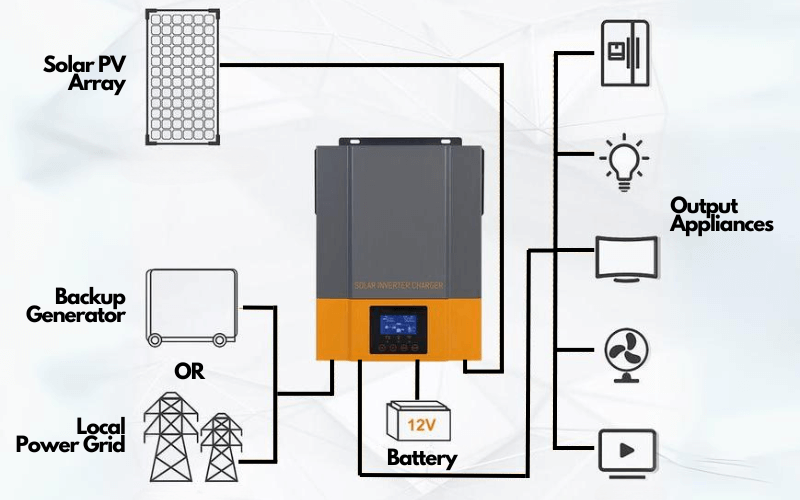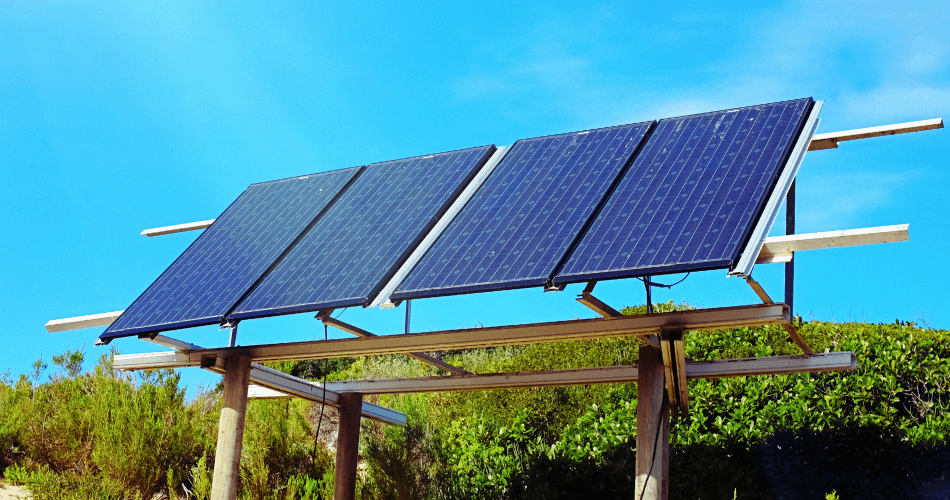Solar energy, while environmentally beneficial, can seem like an enigmatic subject, especially when it comes to living off-grid. Many are intrigued by the idea of detaching from utility companies and generating their own power.
But what does it truly entail? How much solar infrastructure is needed? Are there pitfalls to be aware of? Here’s a first-hand glimpse into the life of off-the-grid, empowered by solar energy.
Table of Contents
Why Off-grid Solar Systems?
Powering a home in a remote location is not an easy task. There should be suitable infrastructures like substations, transmission lines, distribution centers, and many more. So it may cost around 30k to 100k USD to set up those utilities from the beginning.
Therefore, off-grid systems are ideal for remote areas, undeveloped lands, and anyone with no access to utility power. Smaller versions, especially flexible solar panels, can be used to power up mobile vehicles and boats.
How Do Off-grid Solar Systems Work?
A home with an off-grid power system is energy self-sufficient. All power requirements are fulfilled by the onsite solar panels and battery storage. There is no connection to the local electric grid. Let’s find out how an off-grid system powers a house.
Let’s start with the rise of the sun in the morning. Although the sun is not at its full strength yet, the solar array with the battery backup should still generate enough power to meet the home’s needs. This is possible in off-grid homes where residents are careful with their electricity usage and avoid installing appliances that simultaneously use too much power .
At midday, the sun is high in the sky. The solar panels hit their maximum output. Also, this is when energy needs are lowest, as most family members are out. So, the surplus energy is sent to charge the batteries. This is also a good time to operate energy-hungry appliances like air conditioners, washing machines, or water pumps.
In the afternoon, the sun moves lower in the sky, so PV output starts to fall. However, solar panels may still produce some power than needed. So, if the batteries aren’t full yet, the extra power will be used to bring them up to 100%.
With the sun setting in the evening, solar panel output falls to zero while power usage spikes. Because family members return home and fire up their electrical appliances, and the stored energy will be drawn back from the batteries to meet this demand.
At night, the daily power cycle is complete. No solar power will be generated until the next day morning. Until then, all the nighttime energy needs will be met by the batteries. This won’t be a problem for a well-designed off-grid system. It should be able to store enough electricity to last two or three days without much sun.
Of course, keeping ample backup power in reserve requires a lot of battery capacity and more solar panels to charge them. This makes off-grid systems expensive compared to simple grid-connect systems or even hybrid systems. So, let’s discuss those possible solutions in the latter part of this guide series.
How Much Solar Do I Need for Off-grid Living?
The beauty of going off-grid solar is its flexibility. How much you need primarily depends on your consumption. The more energy you use, the more robust your solar and battery infrastructure needs to be.
So, to determine the size of your solar array, first, understand your consumption patterns. In the next part of this series, we have a descriptive guide on demand calculation. Also, we will introduce you to our in-built off-grid solar calculator.
Drawbacks and Downsides of Living Off the Grid
While the freedom of generating your own energy is liberating, it comes with its own set of challenges. Here are some to consider:
Dependency and Responsibility:
Living off-grid means you’re your own utility. When there’s a glitch, you’re in charge. You either roll up your sleeves or wait for an expert to come.
Energy Management:
This lifestyle demands active involvement. Living off-grid requires you to be vigilant, from using energy-efficient appliances to monitoring consumption.
Unexpected Outages:
If your system falters and your service provider isn’t immediately available, you might face a power cut. It’s not fun when you’re in the middle of something crucial!
However, this is not an inherent issue for off-grid systems; it is even common for all types of power systems. The plus point is that you can rectify the breakdowns immediately if you have the basic knowledge. No worries! Hold on to learn how you can solve that kind of problem.
Life Expectancy of an Off-grid Solar System
The longevity of your off-grid solar system largely hinges on its components. For example, if you use flooded lead-acid batteries, it may demand regular maintenance. Every few months, you may have to ensure their electrolyte level is optimal. But if you use Lithium Batteries, there will be no regular maintenance other than the initial cost.
The solar panels themselves can last two decades or more with proper care. It’s a mix of periodic maintenance and keen oversight that ensures a longer lifespan for your setup.
Is Going Off-grid Worth It?
To some, living off-grid might seem like a romanticized notion. To others, it’s a conscious decision aligned with sustainability. In my journey since 2007, I’ve realized it’s not just about being eco-conscious; it’s a lifestyle choice. While I’ve had my share of challenges, the independence and connection to nature make it worthwhile.
Approximated cost for an Off-grid Solar System
The approximated cost for an Off-grid solar system may vary depending on the system size and type. For an average-sized system, it may cost from 4000 USD to 7000 USD. Also, you can save installation costs by making it DIY. Here, we provide a complete step-by-step guide if you set up your system yourself.
For example, let`s do a rough cost breakdown for a 3kW system.
| Component | Details | Cost(USD) |
|---|---|---|
| Inverter: | Let`s assume we are using a Hybrid Inverter that can be used with grid backup | 750 |
| Solar Panels. | Let`s assume our daily energy demand is around 5kWh. | 2000 |
| Battery Backup. | Let`s assume our days of autonomy are 1 day, and we use Lithium batteries. Then, we will need a battery storage of 5kWh. | 850 |
| Other infrastructures. | Solar mountings, Wires, Connectors, Circuit Breakers, Isolators, Protection Relays, fuses, etc. | 1500 |
Total Cost = 5100 USD
Off grid-Hybrid Solar Systems
Depending on your location, there might be days that the sun is not generous. So, it’s better to have a Hybrid system with additional backup power source. Hybrid Systems come in two different forms:
- Hybrid with Additional Renewable Sources
- Hybrid with Grid Backup
Harnessing Backup and Additional Renewable Sources
Solar isn’t the only player in this game. You can add other types of renewable energy resources like wind turbines or micro-hydro generators. As well as we can oversize the PV array to cover our demands in the wintertime.
But having those resources is really site-specific, So everybody cannot access those resources. If there are no additional renewable resources, it’s usually a good idea to have some sort of fossil fuel generator. It’s not the greenest option, but a reliable plan B. Then, you will not lose power even in a long snowstorm or a period of cloudy weather where the solar array can’t cover all of our demands.
Off grid-Hybrid System (Off-Grid with Grid Backup)
The next type of hybrid solar PV system is grid-tied with battery backup. These systems are ideal for anyone with unreliable power and critical appliances like water pumps, lights, or security systems.
How Do Off-Grid with Grid Backup Systems Work?
We know that properly designed off-grid systems can power up your home all the time. But there can be inevitable system failures.
With this kind of system, the power grid will energize your home in case of an internal error in your system. The size of your generator will depend on the type of power that is essential in your home.
You can use several methods to incorporate the grid or backup generator with an off-grid Solar System. The first method is using a hybrid off-grid inverter. If you already have connected to the local power grid, you can easily shift to a hybrid system with this method.
The second method is to set up a conventional off-grid system with separate charge controllers and inverters and then use a changeover to select the required power source. There are automatic and manual changeovers that you can use depending on your budget and the requirements.

Approximated cost for Off-Grid with Grid Backup Systems
If you are an off-grid user, there will be only a small cost for the changeover and other infrastructures to make your system hybrid. But for that, there should be a local power grid near your home. If not, there may be an initial cost for those utilities.
What is the best Solar power System for you?
The best-suited solar system for a particular house totally depends on the requirement.
Off-grid systems with grid backup are the most reliable system type. They are ideal for users who need non-interrupted power, even during blackouts.
Off-grid systems require Battery storage to provide stable power output, So it has additional costs for maintenance and upfront. But if you are totally away from the grid, there are no solutions other than the off-grids.
An off-grid system with additional renewable sources is a hybrid version of multiple systems. However, all the people will not be eligible to set up these systems depending on their location.
Conclusion
In conclusion, going off-grid with solar energy is not only a science but also an art. It’s about understanding the nuances of your consumption, being ready for challenges, and savoring the sweet autonomy it brings.
While there are technicalities to grapple with, the experience, in essence, isn’t vastly different from living in a regular grid-tied house. The lights still turn on with a flick, but behind that simple action lies a tale of independence, resilience, and a commitment to the planet.
